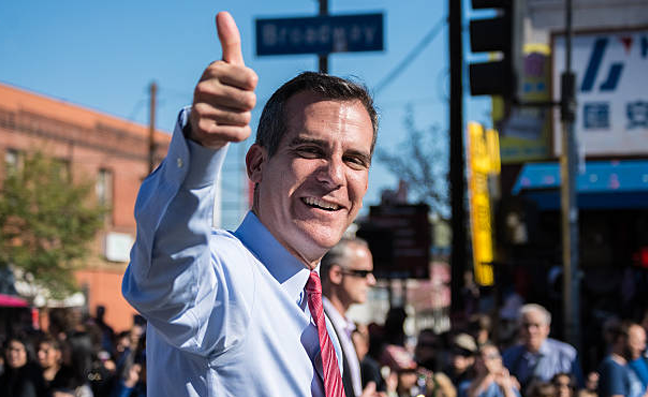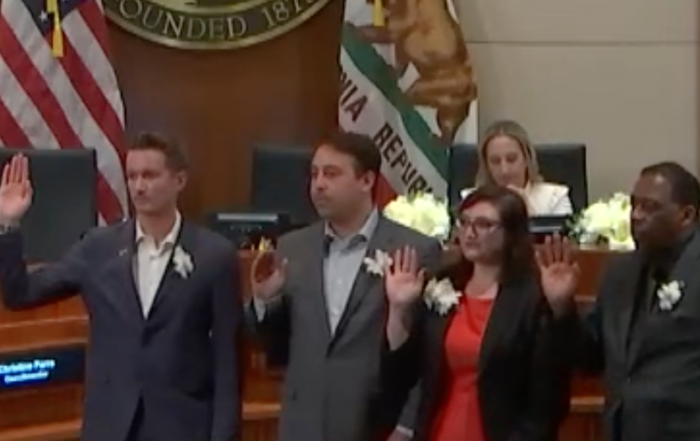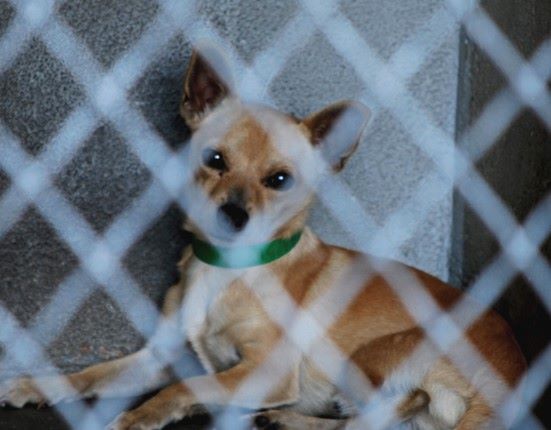Standing in the middle of the newly constructed 6th Street Viaduct, Mayor Eric Garcetti delivered his final State of the City Address today to a modest crowd of onlookers including his family, fellow elected officials, and city department managers.
In his remarks, Garcetti harkened back to the “Back to Basics” agenda he campaigned on in 2013, reminding listeners that on his first day in office, he helped pave a street in the San Fernando Valley. “Today, a pothole gets filled almost six days faster than it did in 2014,” he claimed. “Two-thirds of our streets are listed in ‘good condition’ versus less than half on my first day in office.”
He also spoke of investments in the Port of Los Angeles, LAX, and Metro that will mean arrivals into a higher quality airport that is finally connected to the Metro Green Line. He also reminded attendees of his successful drive to raise the minimum wage to reduce poverty and increase housing construction. “Housing [construction] is rising at three times the rate as when I started,” said the mayor.
Garcetti then spoke of two ongoing aspirations. “We need to make sure this is the safest and cleanest city it can be,” he said. “And we have to build a Los Angeles that is prosperous and protecting by doubling down on our work to build more housing and address our climate emergency.”
Speaking about his legacy, Garcetti said it isn’t his to judge and he doesn’t dwell on it. “With the precious time I have left, I’m more focused on your future than interpreting my past,” he said. “My goal is to hand over a budget to our city council that is stronger than ever; an infrastructure program unequaled in our nation; and a pathway to house our people and save our planet with the urgency that this moment demands.”
He then got into specifics. New sanitation workers funded in the budget will bring down the average wait for pick-up of illegally dumped material from seven days to three. A larger number of “Care Plus” team members will be sent to provide health care and connectivity services to the unhoused. LAPD’s gun buy-back program removed more than 9,000 guns off city streets and doubled the number of “ceased” ghost guns, or untraceable guns.
“Today, homicides are down 7 percent [from] last year even as that number rises in other cities,” said Garcetti. He claimed over his entire term as Mayor since 2013, “We’ve taken over 70,000 dangerous weapons off our streets.” He also went beyond the LAPD, boasting that the city has expanded domestic violence response teams and expanded the Gang Reduction & Youth Development department to cover 50 percent more city territory.
Garcetti then spoke to something on every Angeleno’s mind: Housing. Calling it both a failure at the state and city level, he said, “We have not built enough housing for the people of L.A.” But then quickly defended the actions of his administration and the city council, touting a 300 percent increase in the number of housing units being built in L.A. between 2013 – 2019, and a 600 percent increase in the amount of permanent supportive housing to keep people off the streets and receive services. Garcetti also said that after more than a dozen new transit lines are constructed, the land next to them will be used to build affordable housing. He also teased that L.A. “fell in love” with accessible dwelling units, 10,000 of which have been constructed in many backyards throughout the city in his time.
He wasn’t done there. He boasted about successful efforts to streamline affordable development approvals and shield them from frivolous lawsuits that delay construction. “We created the affordable housing linkage fee,” Garcetti added. “It has already funded affordable housing to the tune of $60 million in subsidy, and is projected to generate over $100 million over the next five years.” Speaking to some negative press received recently on 2016’s Measure HHH to fund housing specifically for the unhoused, the mayor warned, “Don’t believe everything you might hear about HHH. HHH units are coming in cheaper, faster, and more plentifully than we promised voters.”
With the state’s Regional Housing Needs Assessment (RHNA) demanding that L.A. build as many as 457,000 housing units over the next eight years, Garcetti challenged the next mayor to not only meet that goal but to “blow past it.” He said we all need to sacrifice, including our old notions for zoning laws. He says we should “Lean into SB9,” the state’s new law allowing for four units of housing to be built in single-family neighborhoods where there was once only one. He’s budgeted an additional $500,000 in the planning budget for a “Low Rise Design Lab” to create attractive quadplexes and $1 billion additional dollars to “house our unhoused neighbors.”
On the city’s economy, the mayor sounded buoyant about his record of strengthening infrastructure and raising the minimum wage, more than once talking about the need to cure the city’s “addiction to poverty.” He said the city invested nearly $1.1 billion in rental and utility assistance to residents and reminded onlookers that Metro rides are now free for children and community college students. And through “Big Leap,” the mayor said the city is investing in the largest guaranteed income program in the country.
Mayor Garcetti largely closed on the climate fight. Touting the “peace” secured with the Owens Valley, the mayor claimed we’ve returned more water to the Valley in his term and are locally sourcing more of it here. He talked about visiting a new wind farm in New Mexico that has been established that will benefit residents, one he called “the largest wind farm in hemispheric history.” He also said, “We’re building the cheapest solar energy and storage project in the country in the Mojave Desert,” and added, “We’re expanding solar power to communities in South L.A. where it once seemed out of reach.” Recalling his first days in City Hall, the mayor said our renewable energy mix stood only at 2 percent, where it now stands at 62 percent. He championed himself as a great reformer of the Los Angeles Department of Water and Power (LADWP), saying call response times have gone from 40 minutes (according to his father, Gil) down to being answered in two minutes, and an LADWP we can trust with a new Inspector General’s oversight.
“We are ending oil drilling in our own backyards. Can we take that in for a moment?” the mayor pleading the crowd. He added that for what was once a predominantly oil town, “that’s not the closing of a chapter. That’s the beginning of a new book.” He also noted new funds for more electric trucks picking up goods from the Port of L.A. and credited Council President Nury Martinez with the establishment of a $21 million Climate Equity Fund that he says will, “center our mitigation and resilience efforts in the low-income neighborhoods that bear a disproportionate amount of environmental harm.” Garcetti also spoke of city efforts at cooling our climate through large tree-planting efforts and, to date, laying 60 miles of cool pavement in the city.
Mayor Garcetti finalized his remarks with statements of gratitude to individuals he featured in his remarks, fellow elected partners, his family, and the city itself for the opportunity to serve. And he wished the next mayor well, hoping for great things for their time in office.
Stay informed. Sign up for The Westside Voice Newsletter
By clicking submit, you agree to share your email address with Westside Voice. We do not sell or share your information with anyone.








